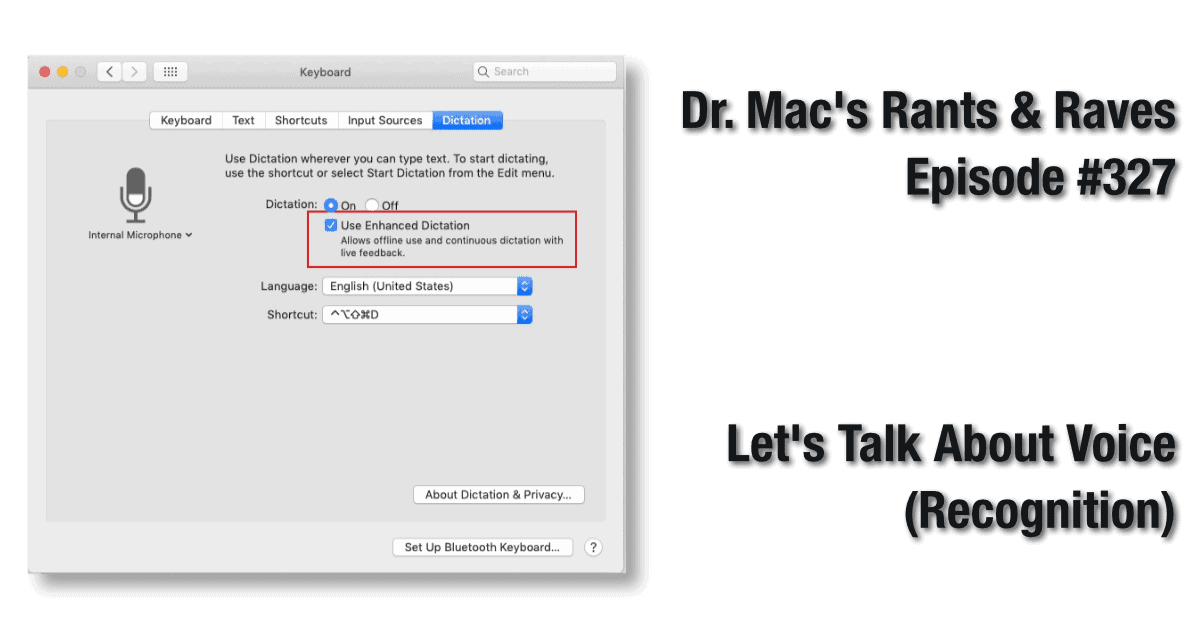
- #DICTATE ON MACBOOK HOW TO#
- #DICTATE ON MACBOOK PDF#
- #DICTATE ON MACBOOK OFFLINE#
- #DICTATE ON MACBOOK MAC#
(When I first started dictating, you … had … to … talk … like … this … leaving … a … space … between … each … word.) My usual tool is Dragon Dictate for Mac. I’ve been dictating to computers for a long time.
#DICTATE ON MACBOOK MAC#
It’s great.īut Mac dictation isn’t new to Mavericks.
#DICTATE ON MACBOOK PDF#
I find myself using it throughout the operating system and in places that I’d never thought of using dictation before, including online forms and annotations to PDF files. With my Retina MacBook Pro, the two microphones are so good that I can even dictate without first donning a headset microphone (a traditional requirement for dictation). In fact, it’s how I’m adding this very text. The feature works anywhere on the Mac that you can enter text, no training or customization necessary. Now, when you press the Fn key twice and start speaking, the words appear on screen as you speak. Having this transcription-support file on your Mac dramatically improves the functionality of OS X’s built-in Dictation feature. To set it up, you go to the Dictation & Speech pane in System Preferences and tick the Use Enhanced Dictation box.
#DICTATE ON MACBOOK OFFLINE#
In OS X Mavericks, you now have the option of downloading a file that supports offline dictation. If something went wrong, you had no idea until you were (a) done speaking and (b) OS X had finished transcribing what you said. My biggest complaint about this implementation was that it didn’t give you any feedback about your dictation until your transcribed text returned to your Mac.

But this feature required an Internet connection and worked for only brief periods of time-about 30 seconds-before your Mac stopped listening to your speech and headed off to Apple’s servers to have your words transcribed. You pressed a key combination (by default, the Fn key twice) and started talking to your Mac, and it recorded and transcribed what you said. While dictation on Mac might take a while to get the hang of, it’s a nifty tool to help users multi-task or get work done when they don’t want to type for long periods.One of the features in OS X Mavericks that I was most looking forward to was offline dictation.īack in OS X Mountain Lion, Apple added the systemwide Dictation tool, similar to Siri in iOS. For example, to dictate the sentence “ I’m fine, how are you?” the user needs to say “I’m fine comma how are you question mark.” Apart from punctuation, there are also specific voice commands for formatting text, such as a new line, a new paragraph, capitalization, and more. When using dictation on a Mac, it’s important to keep in mind that the appropriate punctuation must be said as well. The user can either click on the line if it’s correct or make changes if required. If there's text it's unsure of, it will be underlined in blue for review. Mac Dictation Commandsĭictation on Mac is surprisingly accurate when it comes to translating words to text. It also learns over time, so the accuracy improves with more usage. While speaking, dictation takes a few seconds to reformat a sentence.

Once finished, click on "Done" to stop dictation. The user can begin speaking, and it will immediately start displaying the text on the screen from the location of the cursor. A microphone icon will pop up on the side. On the Menu bar at the top of the Mac, click on Edit > Start Dictation. First, open the app where the dictation is being used. Once that's done, the user is ready to start employing dictation on the Mac. Once it's enabled, a language and dialect can be selected, as well as a shortcut key to bring up the feature quickly. On the Mac, go to the Apple menu > System Preferences, and click on Keyboard and Dictation.

To enable dictation, the user first needs to turn it on via their system settings.
#DICTATE ON MACBOOK HOW TO#
Related: How To Change Siri Voice On A Mac (macOS Sierra Or Later) On Mac, dictation also displays the text as a person is speaking, so they can see the live preview and pause to make changes. Siri does have a few limitations though, and these are mainly restricted to the use of third-party apps. Mac’s dictation feature on the other hand works anywhere a keyboard is used and can be utilized offline too since it functions just like a voice-to-text feature. Siri can be used to search for a particular file or folder, bring up an app, answer questions, or even change a Mac’s settings.

It's especially useful when writing long emails or drafting lengthy documents. It's important to note that Mac's dictation feature differs from Siri, which is Apple’s built-in voice assistant. For some people, speaking out loud is a more effective way to express their thoughts compared to typing. Voice dictation is a neat feature that’s built right into a Mac, letting users employ their voice to dictate and type for them.


 0 kommentar(er)
0 kommentar(er)
